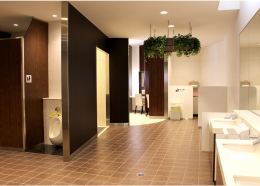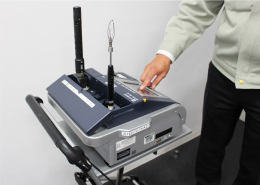- TOP
- > What We Do
- > Environmental Health Management Work
We perform daily cleaning, periodic cleaning, special cleaning, plant management, etc., mainly targeting large-scale commercial facilities and hospitals, and also restaurants, convenience stores and public toilets, etc. For buildings (Specified Buildings, etc.) which come under the Buildings Management Act, annual plans must be created and kept for three years.

●Daily cleaning
In order to maintain a building's appearance and keep its environment in a hygienic state, its floors, toilets, escalators, furniture, fixtures, etc. are cleaned on a daily basis. Introducing the Biocare System or AN21 System will give excellent deodorizing, cleaning and sterilizing effects.
●Periodic cleaning
A schedule is decided on, such as once to twice a month, and periodic cleaning is carried out. Dirt that cannot be completely removed through daily cleaning is removed using the appropriate cleaning materials and equipment. The work includes cleaning and waxing the floors, cleaning the carpets, cleaning the glass, and work in high places.
●Special cleaning
The time is taken to thoroughly remove accumulated dirt, without imposing a burden on the building. This is carried out once to twice a year. The work includes cleaning the fluorescent lights, anemostats (nozzles), air intake and exhaust ducts and cooking ducts, and strip cleaning the floors.
Periodic inspections and maintenance are required by laws such as the Buildings Management Act, in order to maintain and manage hygienic and comfortable environments.

●Air environment management
Certain regulations have been provided in the Buildings Management Act for the air environment inside buildings. At our company, qualified staff carry out air environment measurements, and in cases where environmental measurement standards are not met, they identify the causes and repair the equipment, etc.
●Water supply and drainage management
Together with carrying out the water supply and drainage management that is prescribed by law, we pay attention to dirt, blockages and deterioration in quality inside pipes, and take measures to resolve them.
1. Water tank cleaning
2. Water quality inspections
3. Measurement of residual chlorine
4. Inspection of water supply facilities
5. Cleaning of sewage tanks and various waste water tanks (building cesspit cleaning)
6. Septic tank management
7. Drainpipe cleaning
8. Graywater system cleaning*
* In large buildings, etc., in order to save water, hand-washing water that has been used once is sterilized and used in water closets. The apparatus for this is called a graywater system.
●Pest control
The Buildings Management Act stipulates that for Specified Buildings with a total floor area of 3,000 m2 or more, control of rats, etc. (including insects) must be carried out once every six months, surveys must be conducted periodically, and measures taken.
●Waste disposal
Garbage is sorted into the various types, and is taken care of by a garbage truck from the local public sanitation department, or by a qualified industrial waste transportation operator.





